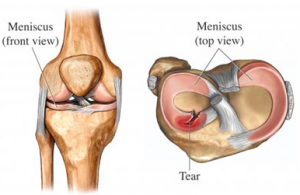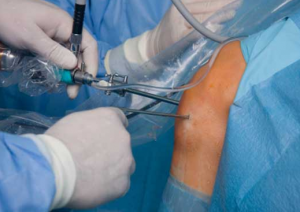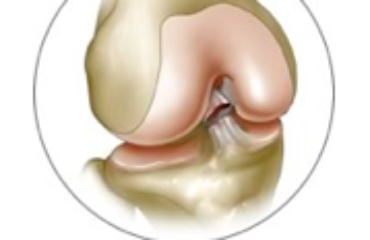Knee Arthroscopy Repair of the Meniscus
Arthroscopic surgery is the standard treatment used to repair a torn meniscus. Tearing of the meniscus usually occurs during activities that require fast stops, starts, cuts, and pivots. Arthroscopic surgery is recommended by Phoenix knee specialists because there are fewer risks and quicker recovery time.
What are the types of meniscus repair surgery?
Surgery for meniscus tears include general repair of the meniscus, meniscectomy, (meniscus removal), and meniscus replacement. Meniscus repair has a low rate of complications and a high success rate. Arthroscopic repair surgery involves the use of a lighted camera (arthroscope).
What is a torn meniscus?
The meniscus is the C-shaped cartilage between the shinbone and thighbone. There are two menisci in each knee joint, the lateral (on the outer side) and the medial (on the inner side). A meniscus tear is a common injury, and it usually occurs through natural tissue degeneration and sports injuries. The menisci provide stability and protection for the knee, so with a tear, the knee becomes unstable.
Who is a candidate for meniscus repair surgery?
There are two zones orthopedic doctors in Arizona consider with meniscus tears: red (outer edge of the meniscus) and white (inner two-thirds of the meniscus). If you have a moderate to large tear on the outer edge of the meniscus, the red zone, then you are a candidate for surgery. Small tears in the red zone usually heal well without surgery. Tears in the white zone do not usually respond well to surgery.
What are the steps of a meniscus repair procedure?
- Step 1 – After general anesthesia is administered, the surgeon will make small incisions at the front and back
 of the knee. The arthroscope is inserted so the surgeon can see inside the joint. Through the other incision, the surgeon inserts small instruments to make necessary repairs.
of the knee. The arthroscope is inserted so the surgeon can see inside the joint. Through the other incision, the surgeon inserts small instruments to make necessary repairs. - Step 2 – With a torn meniscus, there are often loose tissue fragments. These are removed in the procedure.
- Step 3 – The surgeon repairs the tear with fasteners or sutures and closes the edges together. This allows the cartilage to receive adequate blood so it can heal properly. The surgeon may have to shave and trim the tear so blood flow is adequate.
- Step 4 – After repair, the arthroscope and instruments are removed, and the incisions are closed with sutures. A dry bandages is applied. The knee is then wrapped with an Ace bandage, and ice is applied.
What happens after the procedure?
After meniscus repair surgery, you are moved to a recovery area for monitoring. Expect some swelling and pain, which is managed with ice, medications, and elevation of the knee. Because the procedure is an outpatient one, you will leave soon after. We recommend that you do not move the knee for 1-2 weeks.
Will I need physical therapy?
Once home, you will visit a physical therapist who will help you learn exercises for strengthening, improved range of motion, and mobility. Heavy stresses, such as squats and running, are not permitted for several months. It is important to follow the Phoenix sports medicine physician’s orders and participate in the rehabilitation plan for maximum healing.
What is the success rate of arthroscopic meniscus tear repair?
Arthroscopic surgical repair allows you to return to normal knee function with less pain. This procedure is also associated with less long-term complications. The success rate of meniscus repair is around 85%, but success depends on how large the tear is as well as where it is located. In addition, higher success rates are seen in patients who participate fully in physical therapy.


